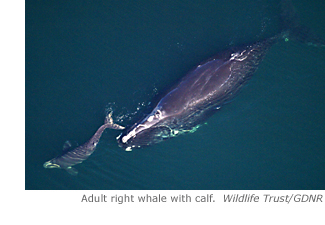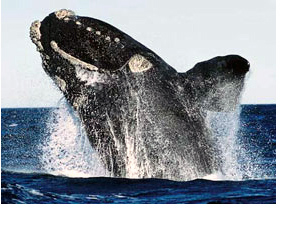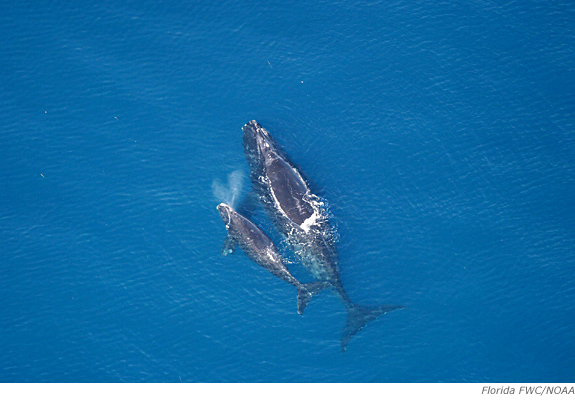Environmental Prediction in the Gulf of Maine
Forecast of North Atlantic right whale births
Implications for right whale conservation
 After centuries of intensive commercial whaling decimated their population, the total number of North Atlantic right whales stands at only approximately three hundred. Today, collisions with ships and entanglement in fishing gear threaten to drive the animals extinct.
After centuries of intensive commercial whaling decimated their population, the total number of North Atlantic right whales stands at only approximately three hundred. Today, collisions with ships and entanglement in fishing gear threaten to drive the animals extinct.
According to some scientific estimates, the North Atlantic right whale will go extinct within 200 years, unless the mortality rate is reduced by preventing collisions and entanglement. Government agencies and non-government organizations have implemented a variety of programs aimed to reduce mortality.
However, a team of scientists led by Andrew Pershing (Cornell University) has found that variability in the birth rate could also be an important factor. Changes in food supply strongly affect the successful reproduction of North Atlantic right whales. During summer, the whales feed in the Gulf of Maine and along the Scotian Shelf near Nova Scotia. They primarily eat Calanus copepods, tiny plankton that somewhat resemble shrimp. Pershing and his colleagues found that Calanus abundance is associated with oceanographic patterns that vary from year to year with the North Atlantic Oscillation (NAO).
Previous studies that estimated 200 years to extinction did not take this variability of the birth rate into account. By incorporating this factor, Pershing's research indicates that the time to extinction may be as little as 100 years. This finding indicates that the plight of the North Atlantic right whale is even more critical than previously thought.
 Because people cannot enhance the whales' birth rate, conservation and management must focus on reducing mortality. Therefore, efforts to decrease human-caused mortality of right whales may need to set more aggressive targets than previously thought, if the species is to survive more than a century. The models developed by Pershing and his colleagues could be used to help determine the necessary targets for reductions in mortality.
Because people cannot enhance the whales' birth rate, conservation and management must focus on reducing mortality. Therefore, efforts to decrease human-caused mortality of right whales may need to set more aggressive targets than previously thought, if the species is to survive more than a century. The models developed by Pershing and his colleagues could be used to help determine the necessary targets for reductions in mortality.
Pershing's model also enables the identification of natural versus human-caused declines in the right whale population. In the mid-1990s, for example, the birth rate was poor. People speculated about possible human causes. However, Pershing's model now makes it possible to attribute that decline in births to a sharp drop in the NAO index, not to human factors. This improved understanding makes it more possible to identify effective management actions to protect the population.
In the future, the forecasts of right whale births could be useful for early warning of ecological problems in the Gulf of Maine. If the number of births in a given year were to fall far short of the forecast, scientists could investigate the anomaly to determine if the cause is related to human activity, such as pollution, or a natural phenomenon not accounted for in the forecast model.



